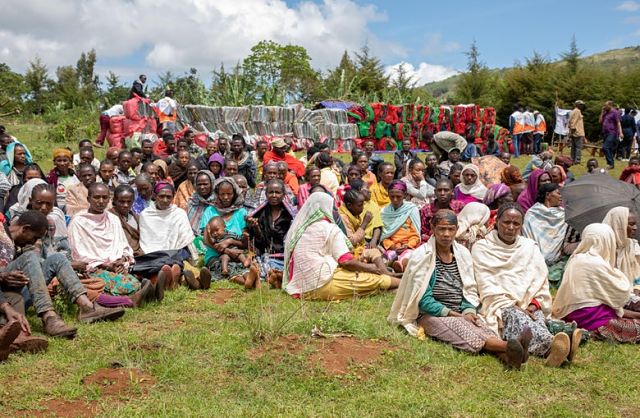 Ethiopia’s current situation brings to mind Alexis de Tocqueville’s famous warning that the most dangerous moment for a government is when it starts to reform. (Photo: A group of internally displaced people waits for aid distribution near shelters at Qercha village on May 20 in southern Ethiopia/ by Yonas Kiros/Getty Images)
Ethiopia’s current situation brings to mind Alexis de Tocqueville’s famous warning that the most dangerous moment for a government is when it starts to reform. (Photo: A group of internally displaced people waits for aid distribution near shelters at Qercha village on May 20 in southern Ethiopia/ by Yonas Kiros/Getty Images)
Slate Magazine
The Biggest Displacement Crisis That Almost No One Is Talking About
The world’s largest new population of displaced people results from a conflict that has received shockingly little international attention: More than 1.5 million people were displaced by violence in Ethiopia last year, nearly all of them internally. This increase doubled the total number of displaced people in the country.
The fact is surprising in part because Ethiopia is enjoying a period of unusually good publicity. Prime Minister Abiy Ahmed, who took over in April 2018, has earned international praise for an ambitious reform agenda that has included freeing thousands of political prisoners, reining in the country’s security services, lifting a state of emergency and restrictions on the media, and resolving a long-running border conflict with neighboring Eritrea. But Monday’s headlines, which saw the killing of a general accused of plotting a coup attempt, suggest the government’s position is fragile. Ethiopia’s current situation brings to mind Alexis de Tocqueville’s famous warning that the most dangerous moment for a bad government is when it starts to reform.
Now that the government is in a moment of transition, ethnic conflict is surfacing. Much of the worst of the crisis has occurred in the country’s southern region, where hundreds of thousands of people have been displaced by fighting between the Oromo and Gedeo ethnic groups. Abiy is Oromo, and many of his reforms are meant to address the marginalization of several ethnic groups, including his own. But observers say the reforms have emboldened communal violence by Oromos. Tensions between the two groups are not new but have intensified in recent years due in part to competition over scarce farmland and resources. (Ethiopia has one of the fastest-growing populations in the world.) Lynchings, rapes, and beheadings have been reported.
Yohannes Gedamu, an Ethiopian political scientist at Georgia Gwinnett College, said in a phone interview that he doesn’t believe Abiy’s government has stoked the violence but said that the prime minister has failed to adequately address it: “Ethiopia is becoming more fragile in that, when you look at the federal government’s inability to curb the violence.”
Many experts see the current crisis as the consequence of the Ethiopian government’s decision in the mid-1990s to set up a system of ethnic federalism, giving groups a greater degree of political autonomy within nine ethnic-based regional states. The system was meant to quell conflict in a country with nearly 80 ethnic groups. The problem, as Gedamu put it, is that “you cannot give every ethnic group its own state, so you have to somehow make it work. The political parties have also become ethnic in nature. It led to the growth of so many nationalist movements. Every political and economic grievance is voiced by ethnic parties or movements.”
Read the full article at slate.com »
—
Join the conversation on Twitter and Facebook.

























